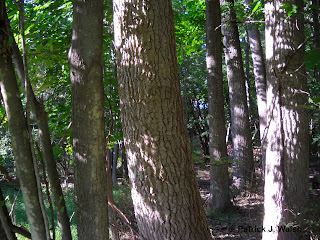As
I walk by, unaware of their doings, a small group of animals gathers in an open
patch of grass in the woods, a short distance from the edge of the paved road
in the park.
They
are discussing their upcoming spring play — a rollicking presentation based on
The Knight's Tale, from Geoffrey Chaucer's Canterbury
Tales.
The
largest of the group, obviously in charge of the production, is a small bear.
He surveys the collection of dramatis personae and, in a quiet aside to his
assistant — a large hare — he begins to run down the list of roles and the
animals necessary to fulfill them:
"So
we've got the owl to play Theseus and the ground hog for Aegeus, and the three deer
for Palamon and Arcite and Emily —"
"Yes,
yes," the hare replies, impatient. "But I've already told you, it's
not the character roles you have to worry about. I'm worried about the
background players — like for instance, who will play the magical forest
creatures who scurry away when the trees are cut down for Arcite's funeral
pyre?"
The
bear replies with a sigh and a wave of his paw — a gesture that, while
unintentional in its effect, nonetheless causes the hare to dodge quickly out
of the way.
"Not
this again — again with the trees?"
"Well
it's important," the hare persists. "It makes a huge impact on an
audience, how the background is constructed. If we're going to have magical
creatures and trees being cut down, we need to think about that."
"All
right, all right. So who do you want for the trees?"
"Well
it depends on what kind of tree
—"
Growing
impatient, the bear brings his paw down heavily on a small clump of wizened
sod, sending a loud ‘whump’ off echoing among the slanted rays of sunlight
scattered through the woods.
“Okay
then,” he responds, obviously trying to stay his annoyance, “what kind of tree?
For instance?”
For
his part, the hare responds with the first small sign of a smile, the corners
of his tiny mouth quivering slightly as he asks:
"Well,
a dogwood, for example. I mean, who can we get to play a good dogwood? What
sort of an animal will be willing to play a dogwood tree?"
Utterly unaware that he is being led toward a punchline, the bear wearily re-traces the hare's rhetorical question in the sprightly wind of the lovely spring afternoon:
"I
don't know… what sort of animal would
make a good dogwood tree?"
Tittering
slightly while taking a beat — and carefully moving himself several steps away
from his much-larger friend — the hare responds:
"Well…
a dog would."
And
somewhere, some half a mile or so away, I stop suddenly in the midst of my
walk, certain that I hear something… something, oddly enough, that sounds sort
of like a large hare, laughing hysterically, and a small bear, moaning indulgently.
As
the sounds fade, I wonder how I’ve come to think of Chaucer and his Tales, as I wander along the edge of the woods, eyeing the rough bark of the dogwoods on this fine sunny
afternoon in the park.
*
* *
Did you know?: The oldest existing reference to the dogwood
tree in an English language manuscript is found in “The Knight’s Tale,” from
Geoffrey Chaucer’s fourteenth century masterpiece The Canterbury Tales (although it is referenced therein in various
iterations by its earlier moniker, the archaic “whippletree,” or as “cornel,”
which is a variant of the scientific name for its genus, Cornus).
©
Patrick J. Walsh


I didn't know the oldest reference to dogwood was in "The Knight's Tale." Can't believe I didn't see the "dog would" joke coming from a mile away ;)
ReplyDeleteIt's a pretty funny joke - the hare laughed REALLY loud :)
ReplyDeleteIt isn't necessarily the oldest reference - just the oldest reference in a still-existing manuscript.
Believe it or not, there's a list of about two thousand words whose oldest existing first reference occurs in manuscripts by Chaucer. I know he's considered to be one of the first to write "in the vernacular" whose manuscripts have survived, but it is really surprising that so many 'first' words are in his work.